
Explain different intergroup relations in terms of their relative levels of toleranceGive historical and/or contemporary examples of each type of intergroup relation
- Subject:
- Social Science
- Sociology
- Material Type:
- Module
- Date Added:
- 11/15/2016

Explain different intergroup relations in terms of their relative levels of toleranceGive historical and/or contemporary examples of each type of intergroup relation

This is a History lesson plan on housing segregation and restrictive covenants in the United States during the 1950s. It is suitable for grades 9 and up. The focus of this lesson is a primary source from Alan Paton available from History Matters. There are also Algebra and English lessons connected to this lesson as noted in this plan.

This kit explores the ways in which King and his legacy have been portrayed in various media forms. The first lesson follows a chronology of King's life through interactive decoding of rich media documents (comic books, billboards, songs, music videos, etc.). The following lessons use excerpts of Dr. King's speeches from 1963, 1967 and 1968 to examine his views on social change; explore the portrayal of King in magazine covers, advertisements, Web sites, film clips and monuments; and use letters to the editor about celebrating King to explore challenges to change.

This course surveys the history of 19th and 20th century Africa. It focuses on the European conquest of Africa and the dynamics of colonial rule, especially its socioeconomic and cultural consequences. It looks at how the rising tide of African nationalism, in the form of labor strikes and guerrilla wars, ushered out colonialism. It also examines the postcolonial states, focusing on the politics of development, recent civil wars in countries like Rwanda and Liberia, the AIDS epidemic, and the history of apartheid in South Africa up to 1994. Finally, it surveys the entrepreneurship in the post-colonial period and China’s recent involvement in Africa.

Redlining was the practice of selectively classifying neighborhoods as most likely to default on repayment of a mortgage loan. Houses in redlined neighborhoods held little value as collateral, and lenders would only offer mortgage loans for these houses at above-average interest rates. Over time, these neighborhoods had the largest concentrations of African Americans. The September 2021 issue of Page One Economics® explains how residents in redlined neighborhoods could not afford to become homeowners and accumulate wealth at the rates other groups did. It also points out how only when the federal government passed laws banning discrimination in housing and banking did the segregation of African Americans to specific neighborhoods start to ease up.

This resource is a video abstract of a research paper created by Research Square on behalf of its authors. It provides a synopsis that's easy to understand, and can be used to introduce the topics it covers to students, researchers, and the general public. The video's transcript is also provided in full, with a portion provided below for preview:
"As materials scientists know well, one reliable way to make strong metals even stronger is to shrink their already-tiny crystalline grains. It’s a time-tested technique that’s made today’s cars, planes, and armor safer than ever. But at the nanoscale, grains are notoriously fickle. Their strong tendency to grow makes it nearly impossible for researchers to chase higher levels of strength. But that could soon change. A new computer model developed by researchers from MIT shows how nano-sized grains might be stabilized in metal alloys. Their findings could provide the blueprint for constructing harder and stronger metals. Alloying one metal with another is one technique that has helped researchers push grain sizes to smaller and smaller scales—thanks to a process known as segregation. As the grains in a metal shrink, the addition of a small amount of an alloying metal segregate, or adhere, to the boundaries between different grains..."
The rest of the transcript, along with a link to the research itself, is available on the resource itself.

No Turning Back immerses young people in daily life under segregation and voter intimidation in the South during the 1960s. Playing as Verna Baker, a fictional teen from the Mississippi Delta, the player experiences and responds to racial restrictions and inequalities known as "Jim Crow," including limited access to education, health care, and voting rights. The TEACH page includes a wealth of materials to support the learning goals of the mission, including comprehension questions, writing prompts, vocabulary activities, and primary source analysis.

As the lesson unfolds, students will get to investigate some of the ways listeners feel and relate to rhythms, focusing on the language used to describe "the beat," and the manners in which rhythms connect to a deeper past and seem to anticipate particular futures. If "the beat" was a concern in 1950s America, it was again a concern for some, decades later, when Gangsta Rap began to dominate the Billboard charts. How far have we come? And how can we study the past to learn more about the future we're making and the music we'll make it with? This lesson gets to the heart of the conflicts that arise as particular rhythms get made, released, listened to, and loved.
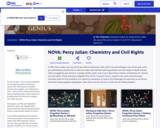
In 1950, Percy Julian was one of the few African Americans with a Ph.D. He was Chicago's man of the year and a groundbreaking scientist. But it wasn't an easy road. Denied teaching positions and the target of death threats, Julian struggled to get ahead in a racially hostile world. Learn more about Percy Julian's contributions to science and civil rights. These resources, adapted from NOVA: Forgotten Genius, explore how Julian revolutionized chemistry with the first synthesis of a chemical compound, as well as the challenges he overcame as an African American facing legalized segregation.
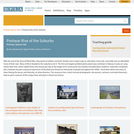
This collection uses primary sources to explore the postwar growth of the American suburbs. Digital Public Library of America Primary Source Sets are designed to help students develop their critical thinking skills and draw diverse material from libraries, archives, and museums across the United States. Each set includes an overview, ten to fifteen primary sources, links to related resources, and a teaching guide. These sets were created and reviewed by the teachers on the DPLA's Education Advisory Committee.

This unit explores perspectives on the central issues of the Progressive Era. Students examine the middle class reformers' attitudes towards immigrants; draw inferences about historical context by analyzing documents that relate to segregation of San Francisco schools in 1906; and question the reliability of Jacob Riis's photographs as accounts of the past. The unit includes cognitive modeling lessons - one that compares the perspectives of Booker T. Washington and W.E.B Dubois, and one that juxtaposes muckracking journalist Lincoln Steffens with political boss George Plunkitt. The Background on Woman Suffrage prepares students for the Anti-Suffragists lesson plan on why Americans opposed woman suffrage.

This lesson focuses on early Asian immigrants to the United States, their reasons for immigration, successes they experienced, challenges they faced, and the changing reception they received in their host country. Students will learn what an immigrant is, what it means to be an “American, what the American Dream is, and how primary sources and secondary sources provide varied perspectives that inform a deeper understanding of an event.
2021 Social Science Standards Integrated with Ethnic Studies:
Civics and Government: K.1, 3.2, 5.1
Historical Knowledge: 2.16, 5.22
Historical Thinking: K.17, K.18, 2.22
Social Science Analysis: 1.19, 1.21, 3.18, 3.19, 4.24, 5.27
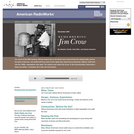
Remembering Jim Crow is a companion to a radio documentary, and examines the system that, for much of the 20th century, barred many African Americans from their rights as U.S. citizens. Read personal histories of segregation. See a sampling of Jim Crow laws. Learn how African Americans fought economic hardships imposed by Jim Crow and how they built social institutions to combat segregation.
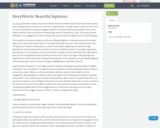
StoryWorks develops inclusive and transformative educational theater experiences that provide students with the opportunity to examine our country’s civil rights history. Through content consistent with school curriculum standards, the program engages students in experiential learning and inspires them to ask deeper questions about the historical underpinnings behind contemporary issues. The process creates pathways to civic engagement, creates lasting memories and instills a tangible sense of social belonging. This StoryWorks educational project is built around Beautiful Agitators, a theatrical play about Vera Mae Pigee, a hair stylist and business owner in Clarksdale, Mississippi, and one of the unsung heroes of the civil rights era. Using her beauty parlor as a hub for Delta-based organizing and resistance, Pigee operated her salon by day and then transformed it into a clandestine center for civil rights organization and education in the evenings. Known for her big hats and larger than life personality, Mrs. Pigee led the direct action that registered nearly 6,000 African Americans to vote in the region. Although Pigee was largely left out of the history books, along with many women of the movement, our play Beautiful Agitators and accompanying curriculum revives her legacy, highlighting her methods and tactics. Inspired by the innovative K-12 civil rights education standards developed by the Mississippi Civil Rights Commission. Our commitment is to expand upon the standards by further developing content related to social justice, power relations, environmental justice, diversity, equity, mutual respect, and civic engagement. Beautiful Agitators combines inquiry with higher-order thinking skills of analysis, evaluation and synthesis. Set in a beauty parlor owned and operated by a Black woman in the Mississippi Delta, our curriculum is based on our investigation into primary sources and their relationship to critical moments in the national movement. This foundation of historical context allows for students and educators to find contemporary parallels which further engage learners to reflect upon the legacy of the civil rights movement and the struggles that we, as citizens, continue to grapple with today.View the complete play Beautiful Agitators on the StoryWorks Theater site.Implementation1. Beautiful Agitators Performance Classroom watches a prerecorded, staged reading of the play Beautiful Agitators, which was created and performed by artists from the Mississippi Delta, home of Vera Mae Pigee.2. Lesson Plan Activities Following the eight-lesson plan structure, students will read aloud or act out scenes from the play. This participatory interaction with the text and the historical events promotes a high level of engagement from the students and encourages experiential learning. These activities directly correspond to scenes in the play and to specific content area standards. Teacher leads guided discussions and helps to explain the historical context and theme of each scene. Students/actors have the opportunity to share their experiences having portrayed these historical figures.

Through the play Beautiful Agitators and accompanying curriculum, students will eplore the life of Vera Mae Pigee and the role of the youth activism in the civil rights movement.

In the early 1900s, Mexican Americans, or Chicanos, in California and the Southwest were excluded from "Whites Only" theaters, parks, swimming pools, restaurants, and even schools. Immigrants from Mexico waged many battles against such discriminatory treatment, often risking their jobs in fields and factories and enduring threats of deportation. In 1945, one couple in California won a significant victory in their struggle to secure the best education for thousands of Chicano children.
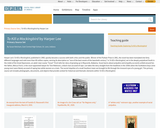
This collection uses primary sources to explore Harper Lee's To Kill a Mockingbird. Digital Public Library of America Primary Source Sets are designed to help students develop their critical thinking skills and draw diverse material from libraries, archives, and museums across the United States. Each set includes an overview, ten to fifteen primary sources, links to related resources, and a teaching guide. These sets were created and reviewed by the teachers on the DPLA's Education Advisory Committee.
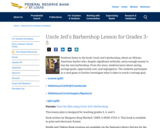
Students listen to the book Uncle Jed's Barbershop, about an African-American barber who, despite significant setbacks, saves enough money to buy his own barbershop. From the story, students learn about saving, savings goals, opportunity cost, and segregation. The students participate in a card game to further investigate what it takes to reach a savings goal.
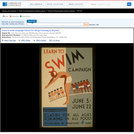
Poster for New York Department of Parks announcing classes forming for swimming lessons, showing African Americans on one side and white children on the other. Date stamped on verso: Jul 22 1940. Poster design by John Wagner.